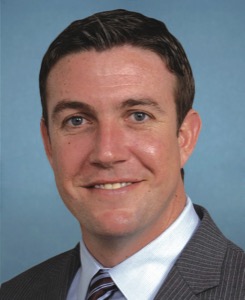
In 2016, Democrats picked up six seats in the House of Representatives, a far cry from the 30 they needed to take control. Many swing state districts were lost by the same voting patterns that cost Secretary Hillary Clinton the presidency, but others were lost due to lack of preparation. Twenty three Republican Representatives were elected from districts that Clinton won, some facing no, or only token, opposition.
If Democrats want to take back the House in 2018, they need to be ready to take advantage of circumstances in their favor. They could start by challenging Rep. Duncan Hunter in CA-50.
Hunter was first elected in 2008 to the CA-52 seat his father left vacant after his presidential campaign. After redistricting, Hunter followed many of his constituents into the new CA-50, where he has won three general elections by a wide margin. Normally, that would put Hunter’s district low on the Democratic takeover list.
What makes Hunter a target for 2018 is the investigation into his possible misuse of campaign funds. On Friday, the House Ethics Committee announced they were deferring their own examination at the request of The Department of Justice, which typically means the latter has opened its own investigation.
At issue are a series of payments from his campaign fund that appear to be for personal expenditures. Hunter’s lawyers have said that any mistakes were “inadvertent and unintentional,” and Hunter and his wife have repaid approximately $60,000 to the campaign “out of an abundance of caution.” Some of the expenditures were reported during the 2016 race that Hunter won, but history suggests voters take Justice Department investigations more seriously. Just ask Clinton, who saw her numbers tank shortly after FBI Director Comey’s October announcement about potentially new emails that in the end added nothing.
A better comparison to Hunter’s situation may be the case of Alaska Sen. Ted Stevens. In 2002, Stevens won his seventh Senate election with 78 percent of the vote. In 2008, Stevens narrowly lost his seat to Anchorage Mayor Mark Begich after federal indictment and conviction on corruption charges (though the indictment was dismissed before sentencing). Stevens’ seat was one of eight pick-ups that eventually allowed Democrats to build their filibuster proof 60 seat majority, after Minnesota Sen. Al Franken’s recount concluded and Pennsylvania Sen. Arlen Specter became a Democrat.
Fair or not, an investigation alone can change a race, even if the target is eventually exonerated. 2018 is starting to look eerily similar to 2006, another midterm election with an energized Democratic base and an unpopular Republican president. That year, Democrats gained 31 seats in the House, six in the Senate, and control of both chambers. If they hope to replicate that success against a difficult 2018 Congressional map, they need to bring back the fifty state strategy that ensured qualified candidates ready to ride the electoral wave anyplace it crested. The CA-50 would be a good place to start.












We have 7 great challengers vying for the seat. CA-50 deserves better. Donate to our opponent crowdpac!